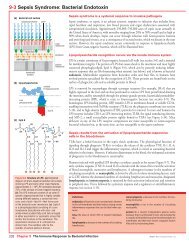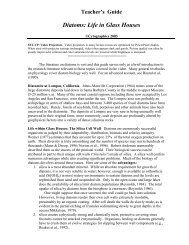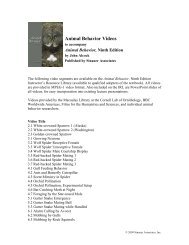Learning the Skills of Research:
Learning the Skills of Research:
Learning the Skills of Research:
You also want an ePaper? Increase the reach of your titles
YUMPU automatically turns print PDFs into web optimized ePapers that Google loves.
Methods<br />
SCAN SAMPLING—Meerkats<br />
Use scan (instantaneous) sampling to record <strong>the</strong> behavior <strong>of</strong> all meerkats that you<br />
see at 30-second intervals for 3 minutes. Using <strong>the</strong> ethogram provided below, enter on<br />
your data sheet <strong>the</strong> number <strong>of</strong> individuals in each behavior category on each scan.<br />
Always begin your scan when <strong>the</strong> stopwatch beeps. Always start your scan at <strong>the</strong> same<br />
location. You may work in pairs, with one member serving as <strong>the</strong> “recorder” and one <strong>the</strong><br />
“observer.” Switch roles mid-way through.<br />
States (for definition, see Exercise 4)<br />
Ethogram<br />
• Forage: Animal consumes or manipulates food or digs in <strong>the</strong> dirt in search <strong>of</strong><br />
food.<br />
• Rest: Animal sits or lies immobile, eyes open or closed, not doing anything<br />
else.<br />
• Play: Animals engage in rough and tumble social interaction or chasing.<br />
• Sentry: Animal stands upright on hind legs, alert, looking at surroundings.<br />
• Locomote (LOC): Animal runs, walks, or climbs around exhibit.<br />
• Social Groom (SOC.GM): Animal uses its teeth or front paws to comb<br />
through ano<strong>the</strong>r animal’s fur.<br />
• O<strong>the</strong>r: Any o<strong>the</strong>r behavior not listed above.












